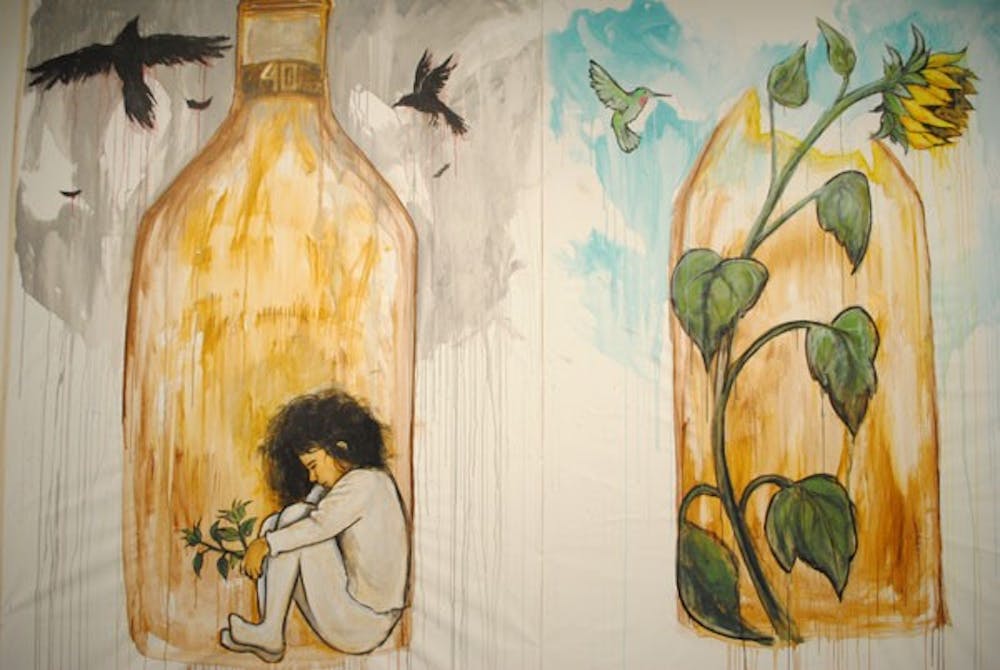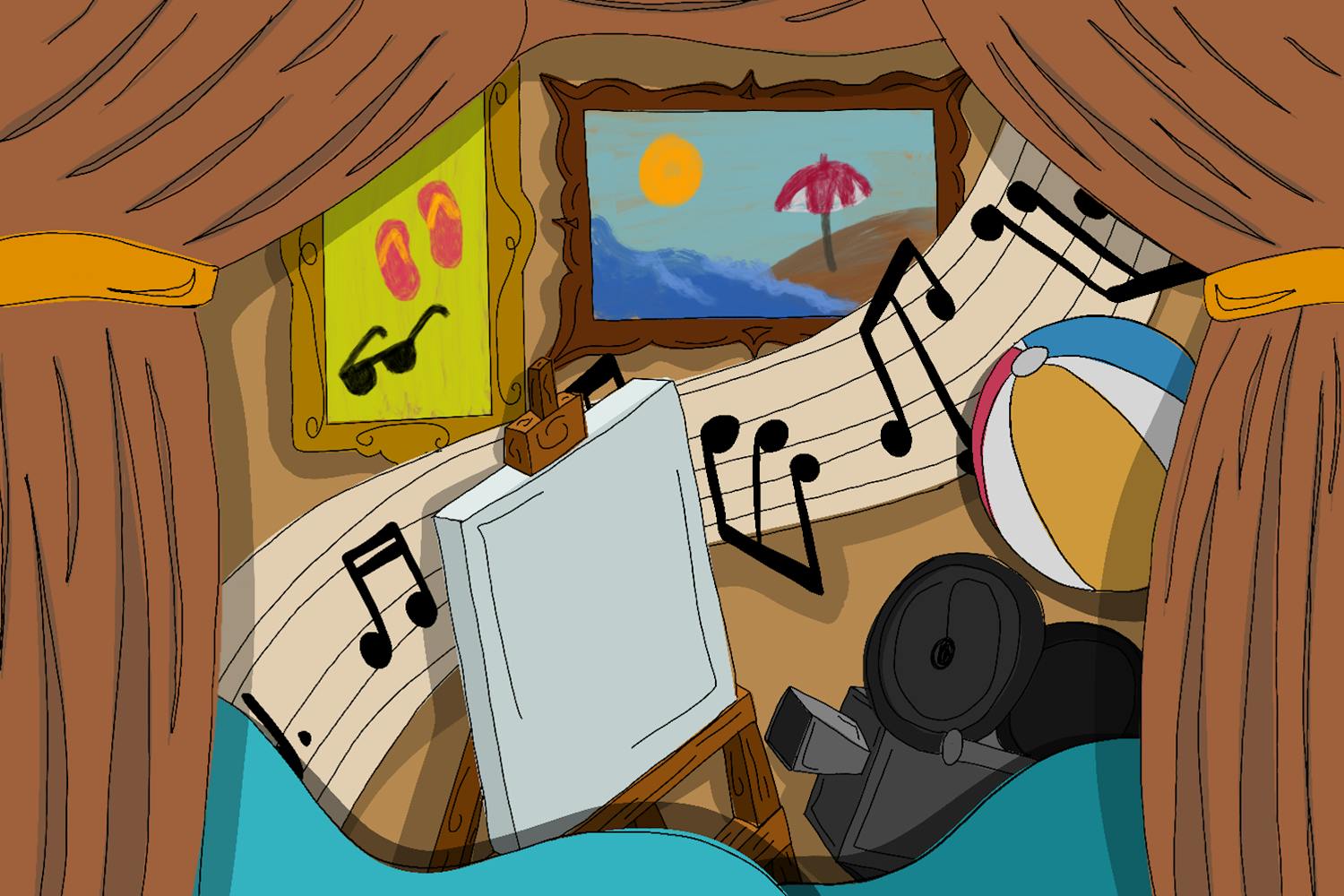 Tom Greyeyes's "40oz Sunflower," which is acrylic on canvas, hangs in the Night Gallery as part of the Map(ing) 2013 exhibit on Jan. 10. (Photo by Yvonne Gonzalez)
Tom Greyeyes's "40oz Sunflower," which is acrylic on canvas, hangs in the Night Gallery as part of the Map(ing) 2013 exhibit on Jan. 10. (Photo by Yvonne Gonzalez)With his face painted in black and white stripes and his long hair decorated with feathers, Johnny Depp crushes a crow perched on his head in ASU alumnus Tom Greyeyes’s limited edition Map(ing) 2013 print.
The print was one of five limited editions produced as part of associate printmaking professor Mary Hood’s biennial project: Multiple Artists Printing (Indigenous and Native Geographies) started in 2009 in part to help curb cultural misappropriation. The concept has become linked with Depp’s portrayal of Tonto in "The Lone Ranger," which is set to release nationwide this summer.
Hood selects artists to spend one week working with a team of art students with printmaking experience. The students work with the artists, some of whose primary discipline may not be printmaking, to create a limited edition of 25 prints.
“All artists picked use art to express indigenous identity in some form of the work that they’re making,” Hood said. “It’s something that they’re always exploring and trying to bring into a contemporary context.”
The artists concluded their week of collaboration with an exhibit and silent auction at ASU’s Night Gallery at Tempe Marketplace on Thursday.
A Kickstarter.com campaign that raised more than $5,000 and the Evelyn Smith Endowed Professor Award, given to Hood by the director of the School of Art, were among the funding sources for this year’s project.
Greyeyes said he began “taking art seriously” in high school when he noticed a lack of political pieces protesting the use of artificial snow at Arizona Snowbowl, a ski resort located on a Navajo Western Sacred Mountain. Fake snow made from reclaimed sewage water was used there for the first time this year.
At ASU, Greyeyes continued to create political art and would eventually spend a day in a Flagstaff jail after constructing several pieces of eco-friendly installation art using mud, rocks and corn husks from a canyon his family plants each year.
In the mud at the base of each piece, he carved “Protect” in Navajo or drew the Navajo Nation’s mountain symbol, hoping to continue to draw attention to the Snowbowl issue. The police wanted to question him and the friends who had been helping him because a vandal had been spray painting “Save the peaks” in Flagstaff the week before, Greyeyes said.
He took printmaking with Hood and was a Map(ing) student collaborator. After graduating, he spent time in San Carlos, Calif., experimenting with street art in the city’s many vacant, semi-burnt down buildings.
“I was trying to learn the things you didn’t learn in college. No one teaches you to use a spray can,” he said. “I learned to work real big.”
One “big” example of his work stretched from floor to ceiling at the Night Gallery exhibit. Called "40oz Sunflower," the acrylic on canvas portrayed a small figure with long dark hair curled at the bottom of a bottle. Next to it was an equally-large bottle holding a sunflower, the petals hanging over a broken glass edge.
In creating his print for the exhibit Greyeyes said he was drawn to Depp by the way “Navajo people are sort of starstruck by him.”
He said Hollywood has a stereotype about native people that Depp claims to be trying to change by playing Tonto.
“When I was little, I asked my dad, ‘What are we? There’s white, black – what are we?’ And he’s like, ‘We’re red people,'” Greyeyes said. “And so I have this image of Depp making himself red by killing the raven that sits on top of his head.”
Greyeyes worked with two students, Emma Ringness and printmaking undergraduate Emily Lewis, to produce Depp’s blood-smeared image.
Lewis took Hood’s introduction to printmaking class and said the social nature of printmaking, not just in the creation of the project but in the ability to repeatedly share the finished product, drew her to the specialty.
The collaboration involved in this project was more professional and came with high expectations, and Lewis said this forced her to become more vocal. She said working with Greyeyes taught her more than the technical aspects of screen printing.
“I learned a lot about Tom’s political views, which were eye-opening,” Lewis said.
Hood chooses artists based on how they’ll be able to work with her current pool of students, as well as how well the student will be able to translate the artist’s vision.
“That relationship is really important not just in developing a cultural understanding, but learning new techniques and new ways of seeing and looking,” Hood said.
Reach the reporter at ymgonzal@asu.edu.




